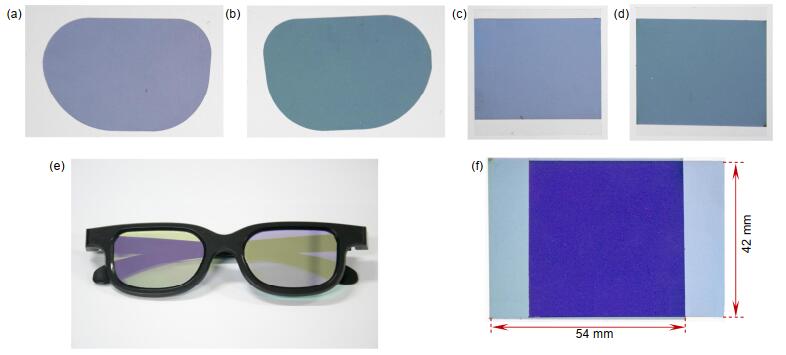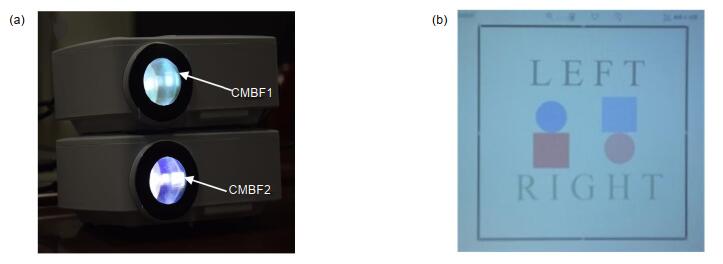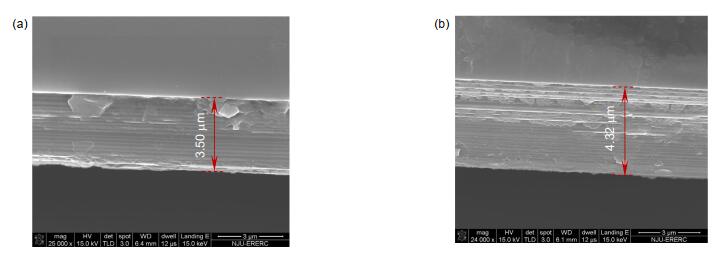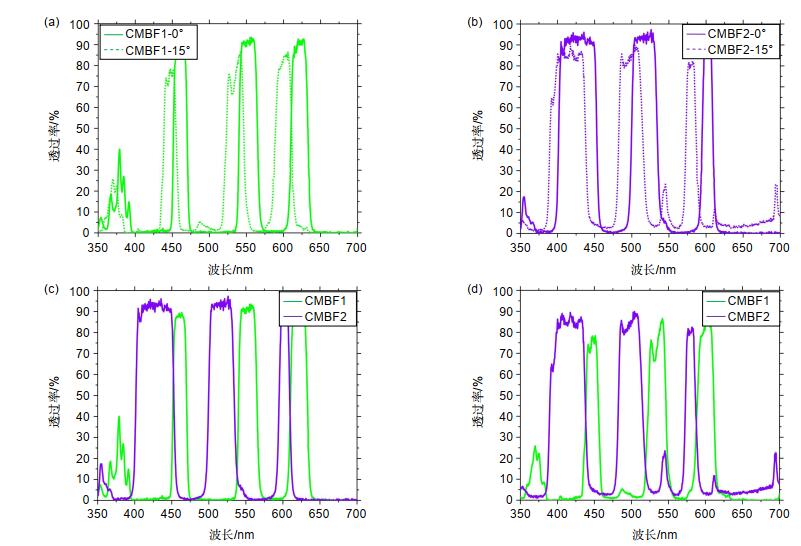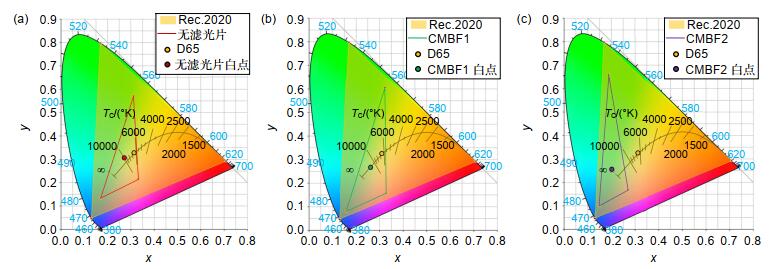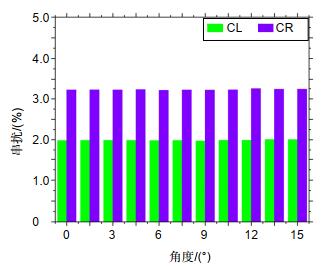-
摘要:
本文提出一个基于互补式多波段带通滤光片的3D投影显示系统,该系统可以使观看者通过特制眼镜获得3D视觉体验。不同于时分复用和空分复用的3D显示系统,该系统借助成对的互补式滤光片实现谱分复用。通过设计可以实现两块滤光片的三对互补通带恰好分别覆盖RGB三色光谱范围,且每对互补通带相互交错几乎不重叠。在本文中,将两台普通的2D投影仪改造成3D投影系统,并测量了该系统的光谱、亮度、串扰等参数,其平均串扰3%,满足3D显示串扰小于10%的基本要求。

-
关键词:
- 3D显示 /
- 互补式多波段带通滤光片 /
- 投影系统 /
- 串扰
Abstract:A 3D projection system based on complementary multiband bandpass filter (CMBF) is proposed in this paper, which enables viewers to gain 3D experience through special glasses. Different from the time-multiplex or the spatial-multiplex system, it is a spectrum-multiplex system using pairs of CMBFs. The three pairs of complementary bandpass of a pair of CMBFs can be designed to cover the three spectrum ranges of RGB individually and in each pair the two bandpass nearly do not overlap. In this paper, a 3D projection system is built from two ordinary projectors and its spectrum, brightness and crosstalk have been measured. The average crosstalk is 3%, meeting the basic requirement of crosstalk in 3D display which is less than 10%.
-
Key words:
- 3D display /
- complementary multiband bandpass filter /
- projection system /
- crosstalk
-

Overview: A 3D projection system based on complementary multiband bandpass filter (CMBF) is proposed in this paper, which enables viewers to gain 3D experience through special glasses. Different from the time-multiplex or the spatial-multiplex system, it is a spectrum-multiplex system using pairs of CMBFs. The three pairs of complementary bandpass of a pair of CMBFs can be designed to cover the three spectrum ranges of RGB individually and in each pair the two bandpass nearly do not overlap. By using the CMBFs, the images from left and right projectors can be divided in spectrum as well. The special glass's lens is same as the corresponding CMBFs appended to the projector. So, the left image can only be seen by the left eye through the special glasses and vice verse. In this paper, pairs of CMBFs which can meet the principle of spectrum-multiplex system are made and a whole 3D projection system is built from two ordinary projectors. This 3D projection system does not need special screen which is common in a commercial cinema. That's to say, by adding several CMBF films, common projection system can be adapted in to a 3D one. The system's spectrum, chromaticity, brightness and crosstalk are also measured in this paper. The spectrum is close to the ideal one, only having a few overlaps which will result in the crosstalk. There are some differences in the chromaticity diagrams between the two CMBFs, which will cause a little chromaticity aberration. This problem can be solved by using FPGA to adjust the input digital images to make the triangle in one chromaticity diagram almost the same as the other one. The brightness is over 110 nits when a pure white image is shown and the brightness is below 4 nits when a pure black image is shown. The left crosstalk is less than 2% and the right crosstalk is less than 3.5%. So the average crosstalk of this system is about 3%, meeting the basic requirement of crosstalk in 3D display which is commonly less than 10%. But the crosstalk of 3D projection in cinema is usually less than 2%. To meet this requirement, an improvement in CMBF's overlap must be done in the future, such as making a better pair of CMBFs without overlaps in spectrum. Besides, the brightness and color are not good enough in this system but can be improved easily for the reason that the screen in our experiment is just a wall.
-

-
图 2 互补滤光片相关设备制备。(a),(b)是由一对切割好的互补滤光片,用来构成图(e)中眼镜的两块镜片;(c),(d)为一对覆盖在投影仪镜头的滤光片;(f)是互补滤光片的相关尺寸和重叠效果
Figure 2. CMBF-related equipment. (a), (b) are a pair of CMBFs prepared before to make the glasses in (e); (c), (d) are a pair of CMBFs to cover the projector lens; (f) is to show the size of the CMBF and the overlap of CMBFs
图 8 色度图。三图中的黄色部分均为Rec.2020标准色域。(a)红色标记未覆盖滤光片的原始投影系统色域;(b)绿色标记覆盖CMBF1的投影系统色域;(c)紫色标记覆盖CMBF2的投影系统色域
Figure 8. Chromaticity diagram. The yellow in each picture marks the colour gamut of Rec.2020. (a) The red marks the color gamut of the origin projector system, without CMBF; (b) The green marks the color gamut of the system with CMBF1; (c) The purple marks the color gamut of the system with CMBF2
图 10 显示亮度测量。(a)左投影仪纯白,右投影仪纯黑亮度测量;(b)左投影仪纯黑、右投影仪纯白亮度测量;(c)左投影仪纯黑、右投影仪纯黑亮度测量
Figure 10. The measurement of the brightness. (a) Measurement in condition that the left image is white and the right image is black; (b) Measurement in condition that the left image is black and the right image is white; (c) Measurement in condition that the left image and the right image are black
表 1 磁控溅射的环境记录
Table 1. Recording of magnetron sputtering environment
材料 TG2(Nb) TG3/4(Si) ICP 电压/kV Ar/(ml/min) 电压/kV Ar/(ml/min) 电压/kV Ar/(ml/min) O2/(ml/min) Nb2O5 10 30/30/40 / 30/30/40 3 40 250 SiO2 / 30/30/40 10 30/30/40 3 40 250 表 2 投影器参数
Table 2. Projector's parameters
分辨率 对比度 帧率/Hz 尺寸/cm 最佳距离/m 接口 功率/W 800×480 1000:01:00 60 18.7×14.9×7.7 2.5 HDMI 38 表 3 各系统的色坐标
Table 3. Chromaticity coordinates of each system
红(x, y) 绿(x, y) 蓝(x, y) 白(x, y) Rec.2020 (0.708, 0.292) (0.170, 0.797) (0.131, 0.046) (0.3127, 0.3290) 原始投影仪 (0.333, 0.216) (0.311, 0.570) (0.171, 0.133) (0.2727, 0.3080) 带有CMBF1的投影仪 (0.330, 0.159) (0.326, 0.608) (0.162, 0.083) (0.2657, 0.2706) 带有CMBF2的投影仪 (0.270, 0.169) (0.187, 0.660) (0.149, 0.102) (0.2033, 0.2580) -
[1] 马群刚, 夏军. 3D显示技术[M].北京:电子工业出版社, 2019: 12-47.
Ma Q G, Xia J. 3D Display Technology[M]. Beijing: Publishing House of Electronics Industry, 2019: 12-47.
[2] Park M, Choi H J. A three-dimensional transparent display with enhanced transmittance and resolution using an active parallax barrier with see-through areas on an LCD Panel[J]. Current Optics and Photonics, 2017, 1(2): 95-100. doi: 10.3807/COPP.2017.1.2.095
[3] 李超, 康献斌, 时大鑫, 等.立体显示技术的分类与进展[J].智能建筑电气技术, 2017, 11(6): 47-52. http://www.wanfangdata.com.cn/details/detail.do?_type=perio&id=znjzdqjs201706013
Li C, Kang X B, Shi D X, et al. Classification and development of stereoscopic display[J]. Electrical Technology of Intelligent Buildings, 2017, 11(6): 47-52. http://www.wanfangdata.com.cn/details/detail.do?_type=perio&id=znjzdqjs201706013
[4] Xu B, Wu Q Q, Bao Y C, et al. Time-multiplexed stereoscopic display with a quantum dot-polymer scanning backlight[J]. Applied Optics, 2019, 58(16): 4526-4532. http://www.wanfangdata.com.cn/details/detail.do?_type=perio&id=ab921726d7d5e2ab8e8482c27c3149cd
[5] 李铭.立体电影发展简史[J].现代电影技术, 2014(7): 47-59. doi: 10.3969/j.issn.1673-3215.2014.07.015
Li M. A brief history of stereoscopic film development[J]. Advanced Motion Picture Technology, 2014(7): 47-59. doi: 10.3969/j.issn.1673-3215.2014.07.015
[6] 汤锐彬, 朱雯青, 陈芬, 等.基于红蓝眼镜的立体视频播放器设计[J].微型机与应用, 2015, 34(21): 34-36. doi: 10.3969/j.issn.1674-7720.2015.21.010
Tang R B, Zhu W Q, Chen F, et al. Design of stereoscopic video displayer based on red and blue glasses[J]. Microcomputer & Its Applications, 2015, 34(21): 34-36. doi: 10.3969/j.issn.1674-7720.2015.21.010
[7] Kuroda Y, Nishihara I, Nakata T. Image optimization method of large autostereoscopic display of dual projection types[C]//Proc. SPIE 11049, International Workshop on Advanced Image Technology (IWAIT), 2019.
[8] 陈巍元, 陈达, 赵猛, 等.一种用于三色激光3D投影的滤光装置: 207037321U[P]. 2018-02-23.
[9] Wu H, Jin H, Sun Y, et al. Evaluating stereoacuity with 3D shutter glasses technology[J]. BMC Ophthalmology, 2016, 16(1): 45. doi: 10.1186/s12886-016-0223-3
[10] 李艳.偏振式立体投影系统性能参数研究与仿真[J].嘉应学院学报, 2014, 32(5): 36-39. doi: 10.3969/j.issn.1006-642X.2014.05.008
Li Y. Research and simulation of performance parameters of polarized stereoscopic projection system[J]. Journal of Jialing University, 2014, 32(5): 36-39. doi: 10.3969/j.issn.1006-642X.2014.05.008
[11] 苏元军. ICP辅助磁控溅射制备多晶硅薄膜[D].大连: 大连理工大学, 2011.
Su Y J. Microcrystalline silicon thin films deposited by ICP assistant magnetron sputtering[D]. Dalian: Dalian University of Technology, 2011.
http://cdmd.cnki.com.cn/article/cdmd-10141-1012271915.htm [12] 《数字影院立体放映技术要求和测量方法》术语定义[J].现代电影技术, 2015(2): 52.
Definition of terms in technical requirements and measurement methods for stereoscopic projection of digital cinema[J]. Advanced Motion Picture Technology, 2015(2): 52.
-


 E-mail Alert
E-mail Alert RSS
RSS
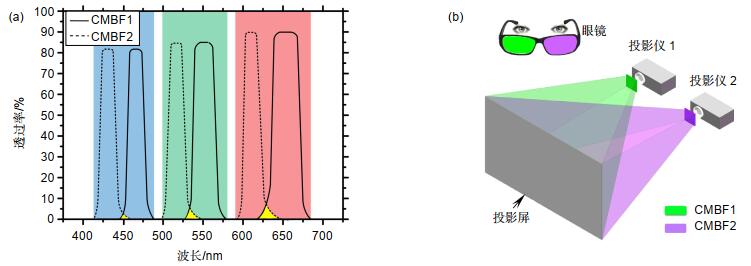
 下载:
下载:
